Exploring Digital Literacy Skills in Social Sciences and Humanities Students
Abstract
:1. Introduction
2. Literature Review and Development of Hypotheses
2.1. Digital Literacies and Competence
- If we focus on language, there are print literacy, texting literacy, hypertext literacy, multimedia literacy, gaming literacy, mobile literacy, and code literacy. Print literacy remains the basis for other kinds of literacies [15], offering the mandatory abilities of reading and writing. As Leu [36] pointed out, “The Internet is a reading and literacy issue, not a technology issue”. In other words, proficient communication with ICT requires both traditional and new skills. Texting literacy supposes the handling of a new linguistic register (netspeak or textspeak) in which we could rapidly communicate. Hypertext literacy refers to the ability to use the hyperlinked structure of the web to achieve or create content. Multimedia literacy recovers many meanings of the term “multimodality” [26] and acknowledges the mixed ways in which we communicate today, combining texts, audio, video, images, graphics, and so on. Gaming literacy means to deal skillfully into a game environment, perform specific tasks, interact with other users, and achieve goals. Games are not used just for fun and entertainment, but also for educative, instructive, or even therapeutical purposes. One emerging literacy is mobile literacy—a complex “macroliteracy” that incorporates many other digital abilities—and, because of the large use of mobile communication for a plethora of goals, became an “instrumental” literacy [28]. The need for a “critical mobile literacy” [28] is natural when a deep familiarity with such a medium is reached and the interrogations about its consequences are asked. Code literacy represents the ability to learn a new language and a new way of creativity—the computer language. The possibility to read or write code, to build a new application are now important skills in a digitalized world.
- When we focus on information, we get tagging, search, information, and filtering literacies. All of them reflect an essential literacy skill set related to finding information, critically evaluating it, selecting it, and using it for various objectives. These kinds of capabilities compose a pivotal structure for the contemporary citizen that in this way can act as an experimented information gatekeeper that can differentiate between true or legitimate sources and fake ones.
- With a focus on connections, there are personal, network, participatory and intercultural literacies. Using digital platforms and tools could be done to express ourselves and to build a powerful online identity. Being part of an online network could enhance a specific social capital and collaboration [37] and provide meaningful ways to create a “voice”. In the McLuhan “global village” [38], where convergence is a functional mechanism, the cultural hybridization put together various cultures and traditions. An interculturally literate individual has the competencies necessary to understand other cultural contexts and to communicate with people across different cultures. There are essential relationships among skills, participation, empowerment, and education that construct the complex layers of connections literacies.
- With a focus on (re)design, remix literacy represents a macroliteracy involving many kinds of literacies reworked to gain new meanings.
2.2. Digital Divides and Knowledge Gap
2.3. Digital Skills Assessment
2.4. Digital Literacy in Education
2.5. The COVID Pandemic Context and Digital Skills
3. Methods and Data
3.1. Study Design and Data Analysis
3.2. Digital Skills Measures
3.3. Sample and Data
4. Results of the Research
4.1. Descriptive Statistics
4.2. Sources of Digital Skills Accumulation
4.3. Digital Literacy Skills
5. Discussion
6. Conclusions and Directions for Further Research
Author Contributions
Funding
Institutional Review Board Statement
Informed Consent Statement
Data Availability Statement
Acknowledgments
Conflicts of Interest
Appendix A. Constructs and Question Items
| Dimension | Questions |
| Communication and Collaboration digital skills | |
| “I can communicate with others using Skype, WhatsApp, Messenger, etc. or using basic features (e.g., voice messaging, SMS, text exchange)”. | |
| “I can use advanced features of several communication tools (e.g., using Skype and sharing files) ”. | |
| “I actively use a wide range of communication tools (e-mail, SMS, instant messaging, blogs, social networks) for online communication”. | |
| “I can use collaboration tools (e.g., project management software, online spreadsheets) and help edit documents / files created and shared by others (One Drive, Google Drive, Dropbox, etc.) ”. | |
| “I know I can use online services (e.g., e-banking, e-governments, e-hospitals, online payment etc.) ”. | |
| “I pass on or share knowledge with others online (e.g., via social networking tools or in online communities) ”. | |
| Creativity digital skills | |
| “I know how to create/edit something new from existing online images, music or video”. | |
| “I am confident about writing/ create content on a blog, website or forum”. | |
| “I would feel confident putting writing/video/image content I have created online”. | |
| “I can create digital content (e.g., text, tables, images, audio, video files) in at least one format using digital tools”. | |
| “I can use tools for creating webpages or blogs”. | |
| “I can create complex, multimedia content in different formats, using a variety of digital tools and environments”. | |
| Critical thinking digital skills | |
| “I know when I should and shouldn’t share information online and which kind of information”. | |
| “I know how to extract/highlight fundamental concepts and references in the text”. | |
| “I know how to identify and extract specific information in sources like social media”. | |
| “I am aware that my credentials (username/password) can be stolen. I know I should not reveal private information online”. | |
| “I know that on internet not all information is reliable and I know how to check different sources and evaluated online content”. | |
| Information digital skills | |
| “I can use advanced search strategies to find reliable information on the internet (such as using web feeds (like RSS)) ”. | |
| “I use some filters when searching to compare and assess the reliability of the information I find”. | |
| “I can assess the validity and credibility of information using a range of criteria”. | |
| “I can save or store files or content and retrieve them once saved or stored”. | |
| “I classify the information in a methodical way using folders. I make backups of information or files I have stored”. | |
| “Ι can save information found on the internet indifferent formats. I can use cloud information storage services”. | |
| Problem-solving digital skills | |
| “I can take basic steps to protect my devices (e.g., using anti-viruses and passwords) ”. | |
| “I have installed security programmes on the device(s) that I use to access the Internet (e.g., antivirus, firewall) ”. | |
| “I use different passwords to access equipment, devices and digital services and I modify them on a periodic basis”. | |
| “I know how to react if my computer is infected by a virus. I can configure or modify the firewall and security settings of my digital devices”. | |
| “I find support when a technical problem occurs or when using a new program”. | |
| “I can solve most of the more frequent problems that arise when using digital technologies”. | |
| Technical digital skills | |
| “I can bookmark a website and I can download/upload files”. | |
| “I can complete online forms”. | |
| “I can apply basic formatting (e.g., insert footnotes, charts, tables) to the content I or others have produced”. | |
| “I know how to import data into a specific programs and tools (e.g., STATA, SPSS, Eviews, MonkeyLearn, Aylien, Google Cloud NLP API, Amazon Comprehend, Brandwatch, RapidMiner, MeaningCloud) ”. | |
| “I know how to do simple data processing in specific programs and tools (e.g., STATA, SPSS, Eviews, MonkeyLearn, Aylien, Google Cloud NLPAPI, Amazon Comprehend, Brandwatch, RapidMiner, MeaningCloud) ”. | |
| “I know how to reference and reuse content covered by copyright”. | |
| “I can choose the right tool, device, application, software or service to solve (non-technical) problems”. | |
| “I am aware of new technological developments. I understand how new tools work”. | |
| “I regularly update my technical digital skills. I am aware of my limits and try to fill my gaps”. | |
| Digital skills accumulation | |
| Levels of education | Please mention in which education system you have accumulated digital skills. |
| Digital education course attendance | Please mention if you have taken digital skills training courses. |
| Socio-demographic | |
| Age | Please mention age (in years) |
| Gender | Gender |
| Faculty | Faculty |
References
- Mills, K.A. A review of the ‘digital turn’ in the new literacy studies. Rev. Educ. Res. 2010, 80, 246–271. [Google Scholar] [CrossRef] [Green Version]
- OECD. 21st-Century Readers: Developing Literacy Skills in a Digital World. Available online: https://www.oecd.org/publications/21st-century-readers-a83d84cb-en.htm (accessed on 24 October 2021).
- European Commission. Digital Economy and Society Index (DESI) 2020. Available online: https://digital-strategy.ec.europa.eu/en/library/digital-economy-and-society-index-desi-2020 (accessed on 15 October 2021).
- Bratianu, C.; Neştian, A.Ş.; Tiţã, S.M.; Vodã, A.I.; Guţã, A.L. The impact of knowledge risk on sustainability of firms. Amf. Econ. 2020, 22, 639–652. [Google Scholar] [CrossRef]
- Herrmann, K.J.; Lindvig, K.; Aagaard, J. Curating the use of digital media in higher education: A case study. J. Furth. High. Educ. 2021, 45, 389–400. [Google Scholar] [CrossRef]
- Polizzi, G. Digital literacy and the national curriculum for England: Learning from how the experts engage with and evaluate online content. Comp. Educ. 2020, 152, 103859. [Google Scholar] [CrossRef]
- Pérez-Escoda, A.; García-Ruiz, R.; Aguaded, I. Dimensiones de la alfabetización digital a partir de cinco modelos de desarrollo [Eng. Dimensions of digital literacy based on five models of development]. Cult. Educ. 2019, 31, 232–266. [Google Scholar] [CrossRef]
- Eurostat. Individuals’ Level of Digital Skills. Available online: https://ec.europa.eu/eurostat/databrowser/view/ISOC_SK_DSKL_I__custom_1418461/default/table?lang=en (accessed on 30 October 2021).
- European Commission. European Commission Digital Strategy. Available online: https://ec.europa.eu/info/sites/default/files/strategy/decision-making_process/documents/ec_digitalstrategy_en.pdf (accessed on 15 October 2021).
- Murray, M.C.; Pérez, J. Unraveling the digital literacy paradox: How higher education fails at the fourth literacy. Issues Inf. Sci. Inf. Technol. 2014, 11, 85–100. Available online: http://iisit.org/Vol11/IISITv11p085-100Murray0507.pdfzz (accessed on 18 October 2021).
- Godhe, A.L. Digital literacies or digital competence: Conceptualizations in Nordic curricula. Media Commun. 2019, 7, 25–35. [Google Scholar] [CrossRef] [Green Version]
- Spante, M.; Hashemi, S.S.; Lundin, M.; Algers, A. Digital competence and digital literacy in higher education research: Systematic review of concept use. Cogent Educ. 2018, 5, 1519143. [Google Scholar] [CrossRef]
- Brolpito, A. Digital Skills and Competence, and Digital and Online Learning. Available online: https://www.etf.europa.eu/sites/default/files/2018-10/DSC%20and%20DOL_0.pdf (accessed on 14 November 2021).
- Castells, M. The Information Age: Economy, Society and Culture, 2nd ed.; Wiley-Blackwell: Oxford, UK, 2010. [Google Scholar]
- Jenkins, H.; Purushotma, R.; Clinton, K.; Weigel, M.; Robison, A. Confronting the Challenge of Participatory Culture: Media Education for the 21st Century. Available online: https://www.macfound.org/media/article_pdfs/jenkins_white_paper.pdf (accessed on 16 November 2021).
- Kellner, D. New Media and New Literacies: Reconstructing Education for the New Millennium. In Handbook of New Media; Lievrouw, L.A., Livingstone, S., Eds.; Sage Publications: London, UK, 2020; pp. 90–104. [Google Scholar]
- Gilster, P. Digital Literacy; Wiley Computer Pub: New York, NY, USA, 1997. [Google Scholar]
- Belshaw, D.A.J. What is ‘Digital Literacy’? A Pragmatic Investigation. Available online: https://dougbelshaw.com/doug-belshaw-edd-thesis-final.pdf (accessed on 18 October 2021).
- Javorský, S.; Horváth, R. Phenomenon of digital literacy in scope of european cross-curricular comparison. Procedia-Soc. Behav. Sci. 2018, 143, 769–777. [Google Scholar] [CrossRef] [Green Version]
- Martin, A. Digital literacy and the ‘digital society’. In Digital Literacies: Concepts, Policies and Practices; Lankshear, C., Knobel, M., Eds.; Peter Lang: New York, NY, USA, 2008; pp. 151–176. [Google Scholar]
- Rheingold, H.; Weeks, A. Net Smart: How to Thrive Online; The MIT Press: London, UK, 2014. [Google Scholar]
- Dudeney, G.; Hockly, N.; Pegrum, M. Digital Literacies. Research and Resources in Language Teaching; Routledge: New York, NY, USA, 2014. [Google Scholar]
- Barton, D.; Hamilton, M. Local Literacies: Reading and Writing in One Community; Routledge: London, UK, 2012. [Google Scholar]
- Calvani, A.; Cartelli, A.; Fini, A.; Ranieri, M. Models and Instruments for Assessing Digital Competence at School. J. e-Learn. Knowl. Soc. 2008, 4, 183–193. [Google Scholar] [CrossRef]
- Covello, S.; Lei, J. A Review of Digital Literacy Assessment Instruments; Syracuse Universit: Syracuse, NY, USA, 2010; pp. 1–31. [Google Scholar]
- Kress, G. Literacy in the New Media Age; Routledge: London, UK, 2013. [Google Scholar]
- Lankshear, C.; Knobel, M. New Literacies, 3rd ed.; McGraw-Hill: Maidenhead, UK, 2011. [Google Scholar]
- Pegrum, M. Mobile Learning: Languages, Literacies and Cultures; Palgrave Macmillan: London, UK, 2014. [Google Scholar]
- Cope, B.; Kalantzis, M. Multiliteracies: The beginnings of an idea. In Multiliteracies. Literacy Learning and the Design of Social Futures; Cope, B., Kalantzis, M., Eds.; Routledge: New York, NY, USA, 2000; pp. 3–8. [Google Scholar]
- Ong, W. Orality and Literacy: The Technologizing of the Word; Routledge: New York, NY, USA, 1982. [Google Scholar]
- Livingstone, S. Media literacy and the challenge of new information and communication technologies. Commun. Rev. 2004, 7, 3–14. [Google Scholar] [CrossRef] [Green Version]
- Coiro, J.; Knobel, M.; Lankshear, C.; Leu, D.J. Central issues in new literacies and new literacies research. In Handbook of Research on New Literacies; Coiro, J., Knobel, M., Lankshear, C., Leu, D.J., Eds.; Erlbaum: New York, NY, USA, 2008; pp. 1–22. [Google Scholar]
- Baker, E.A. The New Literacies: Multiple Perspectives on Research and Practice; Guilford Press: New York, NY, USA, 2010. [Google Scholar]
- Barton, D.; Lee, C.K. Redefining vernacular literacies in the age of Web 2.0. Appl. Linguist. 2012, 33, 282–298. [Google Scholar] [CrossRef]
- Frau-Meigs, D. Transliteracy as the new research horizon for media and information literacy. Media Stud. Insights Eur. Media Lit. Res. Policy Spec. Issue 2012, 3, 14–27. [Google Scholar]
- Leu, D.J., Jr. New literacies, reading research, and the challenges of change: A deictic perspective. In Fifty-Fifth National Reading Conference Yearbook; Hoffman, J.V., Schallert, D.L., Fairbanks, C.M., Worthy, J., Maloch, B., Eds.; National Reading Conference: Oak Creek, WI, USA, 2006; pp. 1–20. [Google Scholar]
- Christakis, N.A.; Fowler, J.H. Connected: The Surprising Power of our Social Networks and How They Shape our Lives; Brown Spark: New York, NY, USA, 2009. [Google Scholar]
- McLuhan, M. The Gutenberg Galaxy: The Making of Typographic Man; University of Toronto Press: Toronto, ON, Canada, 1962. [Google Scholar]
- Bawden, D. Origins and Concepts of Digital Literacy. In Digital Literacies: Concepts, Policies and Practices; Lankshear, C., Ed.; Peter Lang: New York, NY, USA, 2008; pp. 17–32. [Google Scholar]
- Panke, S. Digital Literacy: An Interview with Doug Belshaw. Available online: https://www.aace.org/review/digital-literacy-an-interview-with-doug-belshaw/ (accessed on 2 November 2021).
- Eshet-Alkalai, Y. Digital literacy: A conceptual framework for survival skills in the digital era. J. Educ. Multimed. Hypermedia 2004, 13, 93–106. [Google Scholar]
- Van Dijk, J.A.G.M.; van Deursen, A.J.A.M. Digital Skills. Unlocking the Information Society; Palgrave MacMillan: London, UK, 2014. [Google Scholar]
- Vodă, A.I.; Radu, L.-D. Investigating Economic Factors of Sustainability in European Smart Cities. Eur. J. Sust. Dev. 2018, 7, 107. [Google Scholar] [CrossRef]
- Iordache, C.; Mariën, I.; Baelden, D. Developing Digital Skills and Competences: A Quick-Scan Analysis of 13 Digital Literacy Models. It. J. Soc. Educ. 2017, 9, 6–30. [Google Scholar] [CrossRef]
- Castells, M. The Internet Galaxy: Reflections on the Internet, Business, and Society; Oxford University Press: Oxford, UK, 2001. [Google Scholar]
- Miller, V. Understanding Digital Culture; Sage Publications: London, UK, 2011. [Google Scholar]
- Van Dijk, J.A.G.M. The Deepening Divide: Inequality in the Information Society; Sage Publications: London, UK, 2005. [Google Scholar]
- Warschauer, M. Technology and Social Inclusion: Rethinking the Digital Divide; The MIT Press: London: UK, 2003. [Google Scholar]
- DiMaggio, P.; Hargittai, E. From the “Digital Divide” to “Digital Inequality”: Studying Internet Use as Penetration Increases. Available online: https://culturalpolicy.princeton.edu/sites/culturalpolicy/files/wp15_dimaggio_hargittai.pdf (accessed on 17 November 2021).
- Helsper, E.J.; Eynon, R. Distinct skill pathways to digital engagement. Eur. J. Commun. 2013, 28, 696–713. [Google Scholar] [CrossRef] [Green Version]
- Vodă, A.I.; Butnaru, G.I.; Butnaru, R.C. Enablers of Entrepreneurial Activity across the European Union—An Analysis Using GEM Individual Data. Sustainability 2020, 12, 1022. [Google Scholar] [CrossRef] [Green Version]
- European Commission. Digital Literacy European Commission Working Paper and Recommendations from Digital Literacy High-Level Expert Group. Available online: https://ifap.ru/library/book386.pdf (accessed on 17 November 2021).
- Morrell, E.; Rowsell, J. Stories from Inequity to Justice in Literacy Education. Confronting Digital Divides; Routledge: New York, NY, USA, 2020. [Google Scholar]
- Martin, A.; Grudziecki, J. DigEuLit: Concepts and tools for digital literacy development. Innov. Teach. Learn. Inf. Comput. Sci. 2006, 5, 249–267. [Google Scholar] [CrossRef]
- Ferrari, A. Digital Competence in Practice: An Analysis of Frameworks. Available online: https://ifap.ru/library/book522.pdf (accessed on 18 November 2021).
- Helsper, E.J.; Eynon, R. Pathways to digital literacy and engagement. Eur. J. Commun. 2013, 28, 1–24. [Google Scholar] [CrossRef] [Green Version]
- Van Deursen, A.J.A.M.; Helsper, E.J.; Eynon, R. Measuring Digital Skills. From Digital Skills to Tangible Outcomes Project Report. Available online: www.oii.ox.ac.uk/research/projects/?id=112 (accessed on 17 November 2021).
- The European Parliament and the Council of the European Union. Recommendation of the European Parliament and of the Council of 18 December 2006 on Key Competences for Lifelong Learning (2006/962/EC). Available online: https://eur-lex.europa.eu/eli/reco/2006/962/oj (accessed on 12 November 2021).
- Vuorikari, R.; Punie, Y.; Carretero Gomez, S.; Van Den Brande, G. DigComp 2.0: The Digital Competence Framework for Citizens. Update Phase 1: The Conceptual Reference Model; Publications Office of the European Union: Luxembourg; Brussels, Belgium, 2016. [Google Scholar]
- Tsatsou, P. Literacy and training in digital research: Researchers’ views in five social science and humanities disciplines. New Media Soc. 2018, 20, 1240–1259. [Google Scholar] [CrossRef] [Green Version]
- Van Laar, E.; Van Deursen, A.J.A.M.; Van Dijk, J.A.G.M.; De Haan, J. The relation between 21st-century skills and digital skills: A systematic literature review. Comput. Human Behav. 2017, 72, 577–588. [Google Scholar] [CrossRef]
- Van Laar, E.; van Deursen, A.J.; van Dijk, J.A.; de Haan, J. Determinants of 21st-century skills and 21st-century digital skills for workers: A systematic literature review. Sage Open 2020, 10, 1–14. [Google Scholar] [CrossRef]
- Tan, A. Why Write with Wikis? In Transforming Literacies and Language. Multimodality and Literacy in the New Media Age; Ho, M.L.C., Anderson, K.T., Leong, A.P., Eds.; Continuum International: London, UK, 2011; pp. 207–222. [Google Scholar]
- Kalantzis, M.; Cope, B. A Multiliteracies pedagogy: A pedagogical supplement. In Multiliteracies. Literacy Learning and the Design of Social Futures; Cope, B., Kalantzis, M., Eds.; Routledge: New York, NY, USA, 2000; pp. 237–246. [Google Scholar]
- Rheingold, H. Participative pedagogy for a literacy of literacies. In The Participatory Cultures Handbook; Delwiche, A., Henderson, J.J., Eds.; Routledge: New York, NY, USA, 2013; pp. 233–237. [Google Scholar]
- Punie, Y. European Framework for the Digital Competence of Educators: DigCompEdu; Publications Office of the European Union: Luxembourg; Brussels, Belgium, 2017. [Google Scholar]
- Zammit, K. Charting a Pathway: Embedding ICT and New Literacies into the Curriculum. In Transforming Literacies and Language. Multimodality and Literacy in the New Media Age; Ho, M.L.C., Anderson, K.T., Leong, A.P., Eds.; Continuum International: London, UK, 2011; pp. 9–22. [Google Scholar]
- Şoitu, D.T.; Johansen, K.J. The Space of Innovation and Practice on Welfare, Health And social Care Education and Practice in Romania and Norway; Scientific Annals of the “Alexandru Ioan Cuza” University: Iași, Romania, 2017; p. 10. [Google Scholar]
- Sanford, K.; Rogers, T.; Kendrick, M. Everyday Youth Literacies: Critical Perspectives in New Times; Springer: Singapore, 2014. [Google Scholar]
- Toquero, C.M. Challenges and opportunities for higher education amid the COVID-19 pandemic: The Philippine context. Pedagog. Res. 2020, 5, em0063. [Google Scholar] [CrossRef] [Green Version]
- Bozkurt, A.; Sharma, R.C. Education in normal, new normal, and next normal: Observations from the past, insights from the present and projections for the future. Asian J. Distance Educ. 2020, 15, i–x. [Google Scholar] [CrossRef]
- Ala-Mutka, K. Mapping Digital Competence: Towards a Conceptual Understanding; Institute for Prospective Technological Studies: Seville, Spain, 2011; pp. 7–60. [Google Scholar] [CrossRef]
- Bozkurt, A.; Jung, I.; Xiao, J.; Vladimirschi, V.; Schuwer, R.; Egorov, G.; Lambert, S.R.; Al-Freih, M.; Pete, J.; Olcott, D., Jr.; et al. A global outlook to the interruption of education due to COVID-19 pandemic: Navigating in a time of uncertainty and crisis. Asian J. Distance Educ. 2020, 15, 1–126. [Google Scholar] [CrossRef]
- Hodges, C.; Moore, S.; Lockee, B.; Trust, T.; Bond, A. The Difference between Emergency Remote Teaching and Online Learning. Available online: https://er.educause.edu/articles/2020/3/the-difference-between-emergency-remote-teaching-and-online-learning (accessed on 26 January 2022).
- Garcia-Morales, J.V.; Garrido-Moreno, A.; Martin-Rojas, R. The Transformation of Higher Education After the COVID Disruption: Emerging Challenges in an Online Learning Scenario. Front. Psychol. 2021, 12, 616059. [Google Scholar] [CrossRef]
- Pilav-Velić, A.; Jahić, H.; Okičić, J.; Selimović, J.; Grabovica, E. Emergency remote learning acceptance among higher education students during COVID-19 pandemic. Proc. Rij. Fac. Econ. J. Econ. Bus. 2021, 39, 325–347. [Google Scholar] [CrossRef]
- Zimmerman, J. Coronavirus and the Great Online-Learning Experiment. Chronicle of Higher Education. Available online: https://www.chronicle.com/article/Coronavirusthe-Great/248216 (accessed on 28 January 2022).
- Heidari, E.; Mehrvarz, M.; Marzooghi, R.; Stoyanov, S. The role of digital informal learning in the relationship between students’ digital competence and academic engagement during the COVID-19 pandemic. J. Comp. Assist. Learn. 2021, 37, 1154–1166. [Google Scholar] [CrossRef]
- Murphy, M.P. COVID-19 and emergency eLearning: Consequences of the securitization of higher education for post-pandemic pedagogy. Contemp. Secur. Pol. 2020, 41, 492–505. [Google Scholar] [CrossRef]
- Lau, K.; Gardner, D. Disciplinary variations in learning styles and preferences: Implications for the provision of academic English. System 2019, 80, 57–268. [Google Scholar] [CrossRef]
- Hu, P.; Zhang, J. A pathway to learner autonomy: A self-determination theory perspective. Asia Pac. Educ. Rev. 2017, 18, 147–157. [Google Scholar] [CrossRef] [Green Version]
- Goodfellow, R.; Lea, M.R. Literacy in the Digital University: Critical Perspectives on Learning, Scholarship and Technology; Routledge: New York, NY, USA, 2013. [Google Scholar]
- Kent State University Libraries. SPSS Tutorials: One-Way ANOVA. Available online: https://libguides.library.kent.edu/SPSS/OneWayANOVA (accessed on 27 November 2021).
- Kim, T.K. Understanding one-way ANOVA using conceptual figures. Korean J. Anesthesiol. 2017, 70, 22. [Google Scholar] [CrossRef] [Green Version]
- Werner, C.; Schermelleh-Engel, K. Structural Equation Modeling: Advantages, Challenges, and Problems. Introduction to Structural Equation Modeling with LISREL. Available online: http://kharazmi-statistics.ir/Uploads/Public/MY%20article/Structural%20Equation%20Modeling.pdf (accessed on 22 November 2021).
- Hair, J.F.; Anderson, R.E.; Babin, B.J.; Black, W.C. Multivariate Data Analysis: A Global Perspective, 7th ed.; Pearson Education: Essex, UK, 2014. [Google Scholar]
- Hu, L.T.; Bentler, P.M. Cutoff criteria for fit indexes in covariance structure analysis: Conventional criteria versus new alternatives. Struct. Equ. Modeling Multidiscipl. J. 1999, 6, 1–55. [Google Scholar] [CrossRef]
- Al Khateeb, A. Measuring Digital Competence and ICT Literacy: An Exploratory Study of In-Service English Language Teachers in the Context of Saudi Arabia. Internat. Educ. Stud. 2017, 10, 38. [Google Scholar] [CrossRef] [Green Version]
- Van Deursen, A.; van Dijk, J. The digital divide shifts to differences in usage. New Media Soc. 2014, 16, 507–526. [Google Scholar] [CrossRef]
- Kang, H.; Ahn, J.W. Model Setting and Interpretation of Results in Research Using Structural Equation Modeling: A Checklist with Guiding Questions for Reporting. Asian Nurs. Res. 2021, 15, 157–162. [Google Scholar] [CrossRef]
- Pangrazio, L. Reconceptualising critical digital literacy. Discourse Stud. Cult. Pol. Educ. 2016, 37, 163–174. [Google Scholar] [CrossRef]
- Buckingham, D. Defining digital literacy. Nordic J. Digit. Lit. 2015, 4, 21–34. [Google Scholar] [CrossRef]
- Buckingham, D. Epilogue: Rethinking digital literacy: Media education in the age of digital capitalism. Digit. Educ. Rev. 2020, 37, 230–239. [Google Scholar] [CrossRef]
- Eurobarometer. Digital Rights and Principles. Available online: https://europa.eu/eurobarometer/surveys/detail/2270 (accessed on 17 February 2022).
- Zhang, X.; Zhou, S.; Yu, Y.; Cheng, Y.; de Pablos, P.O.; Lytras, M.D. Improving students’ attitudes about corporate social responsibility via ‘Apps’: A perspective integrating elaboration likelihood model and social media capabilities. Stud. High. Educ. 2021, 46, 1603–1620. [Google Scholar] [CrossRef]
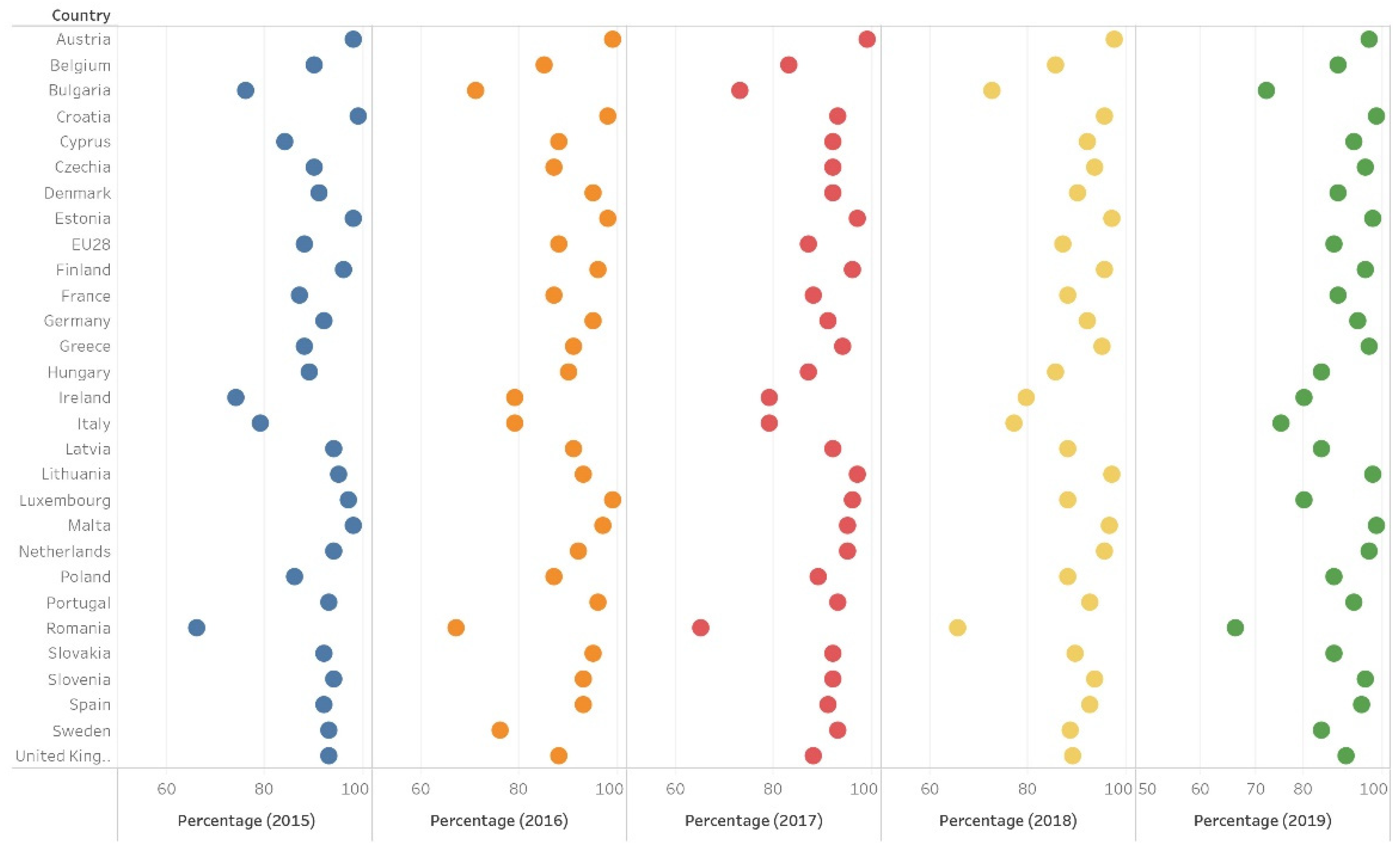
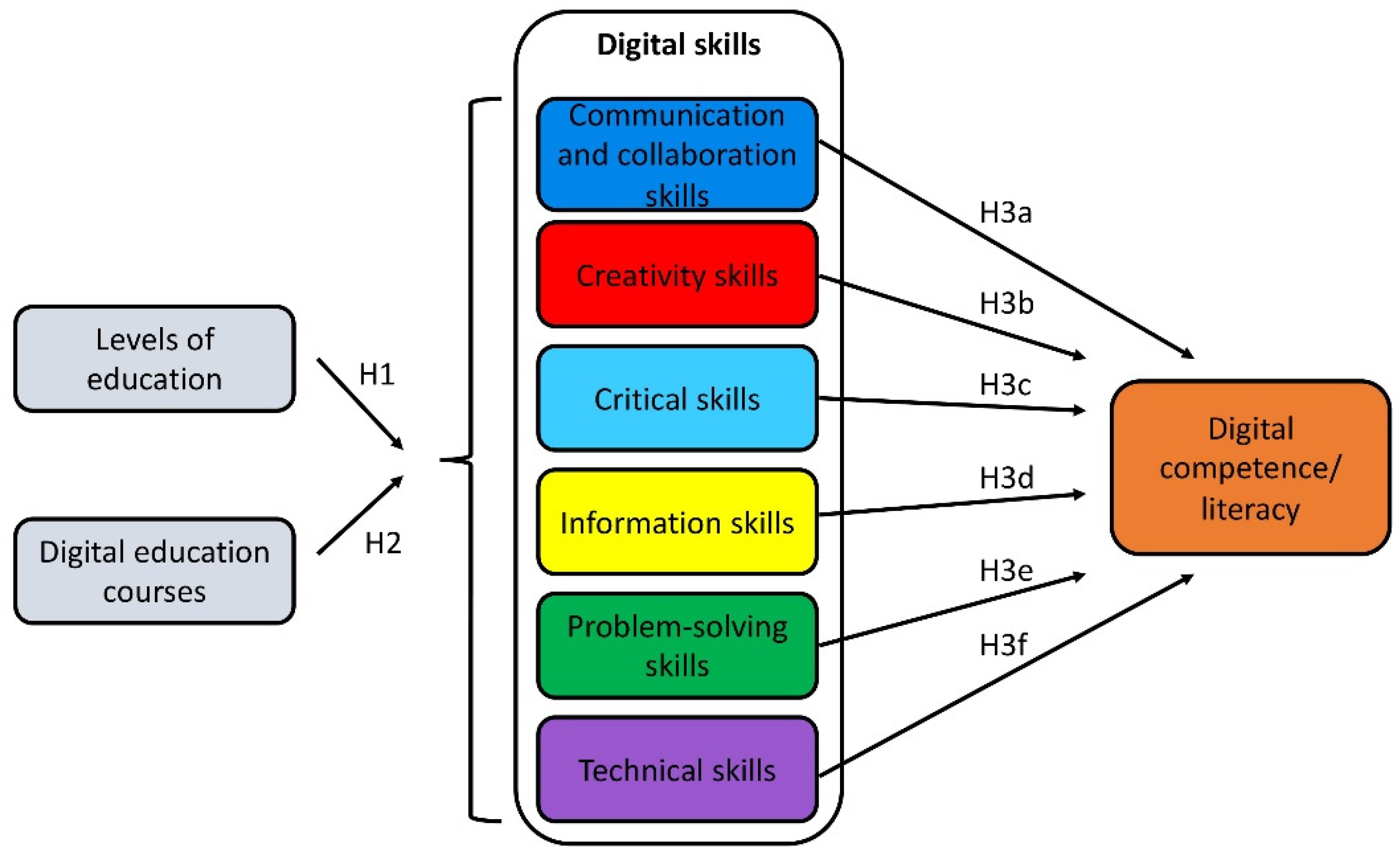
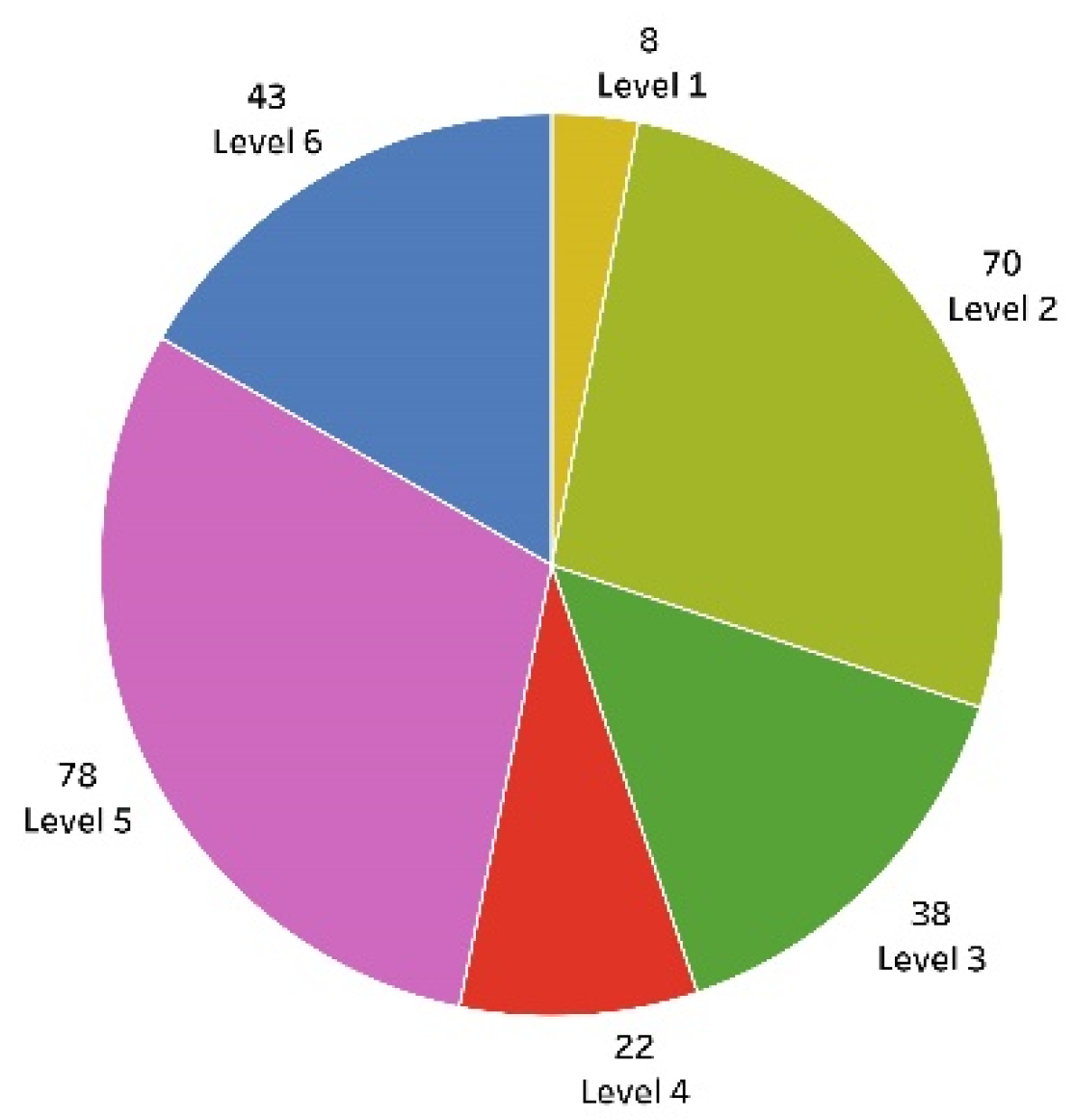
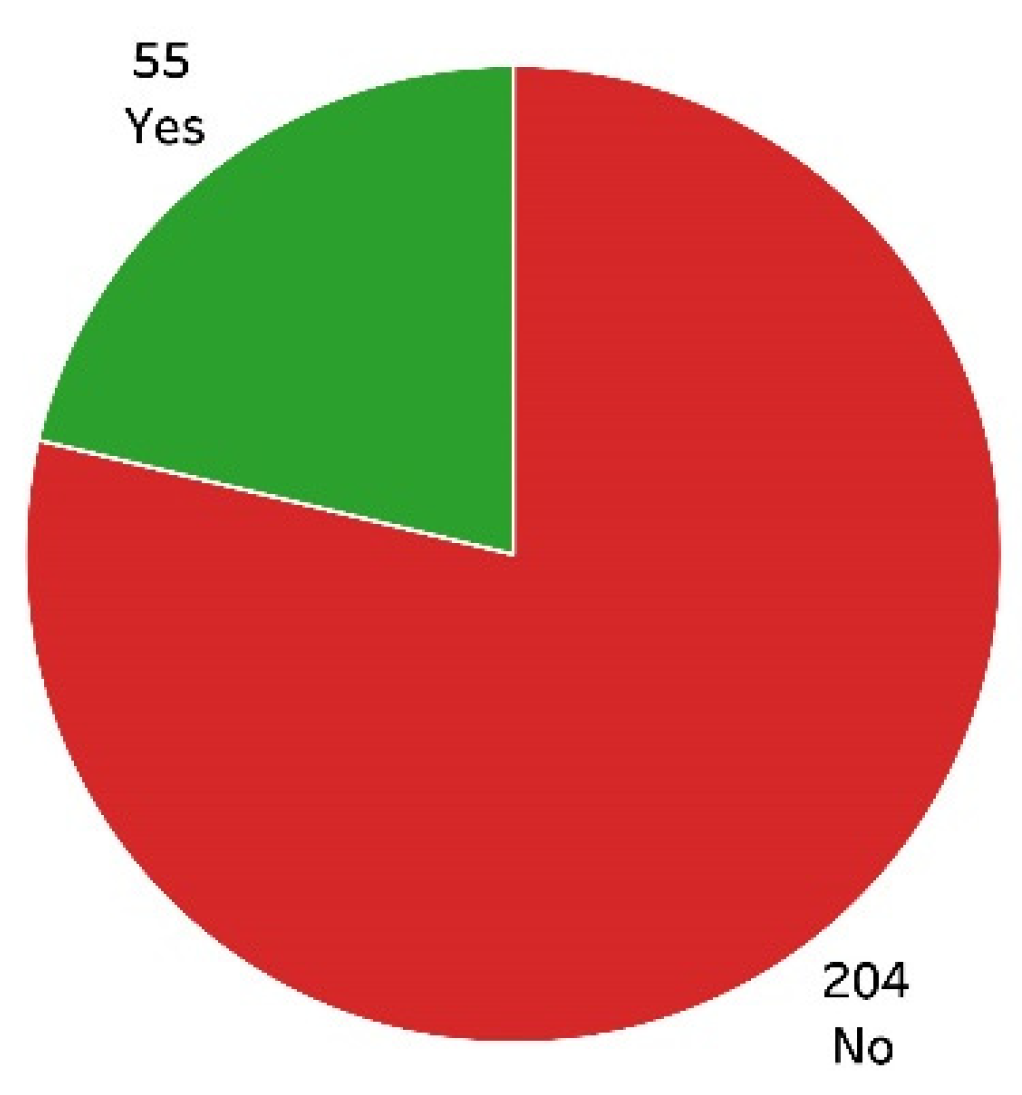
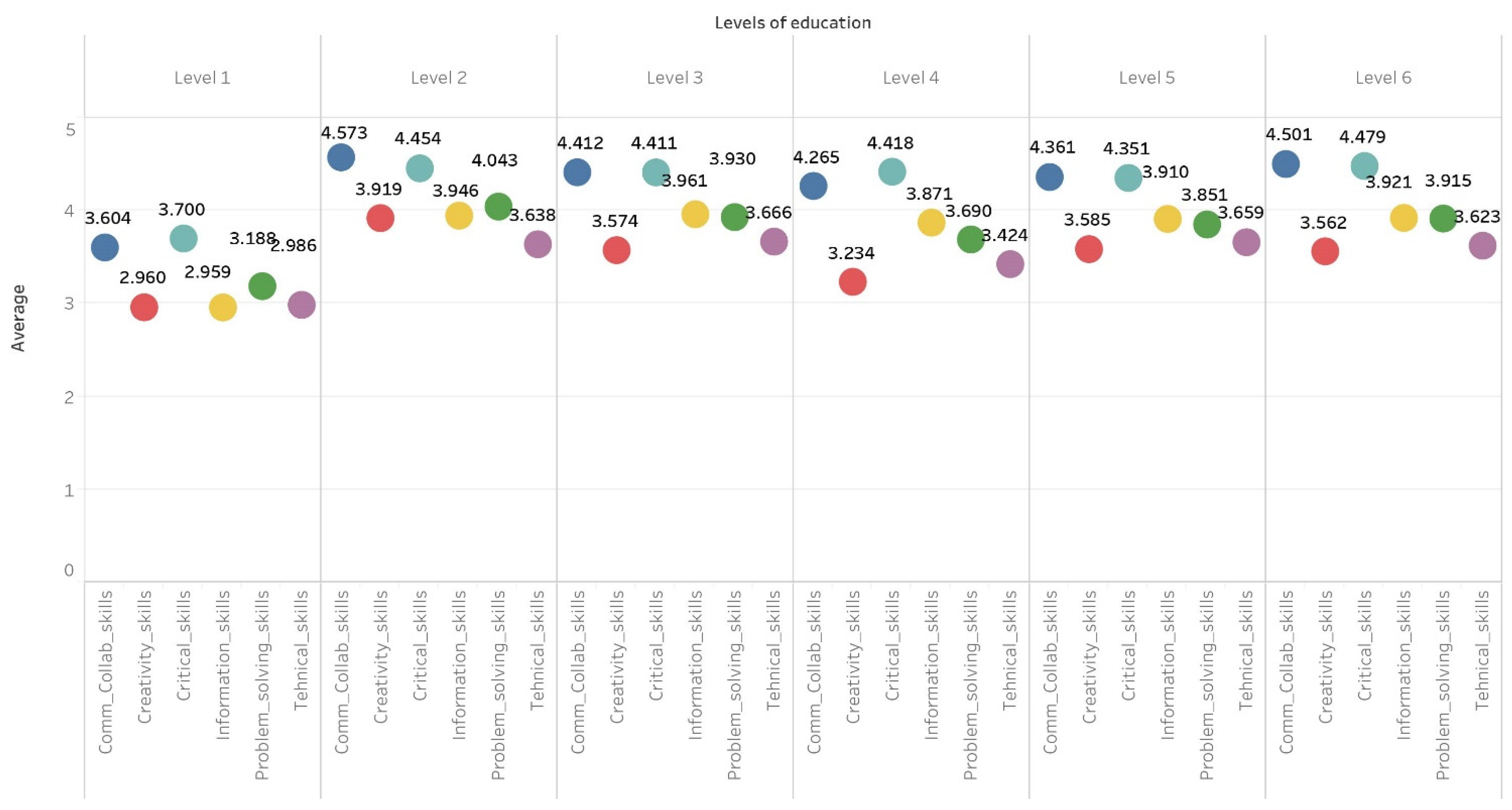
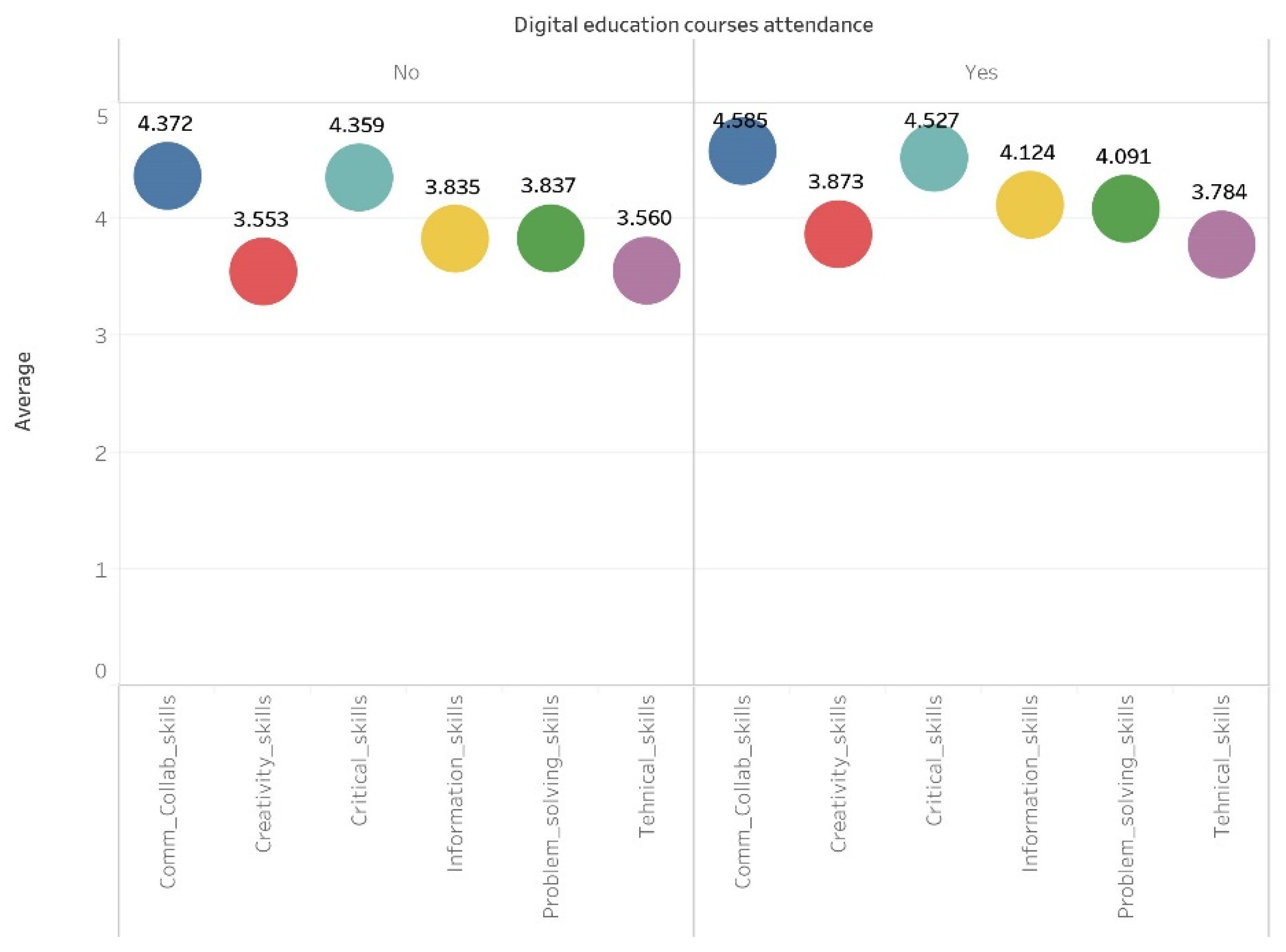
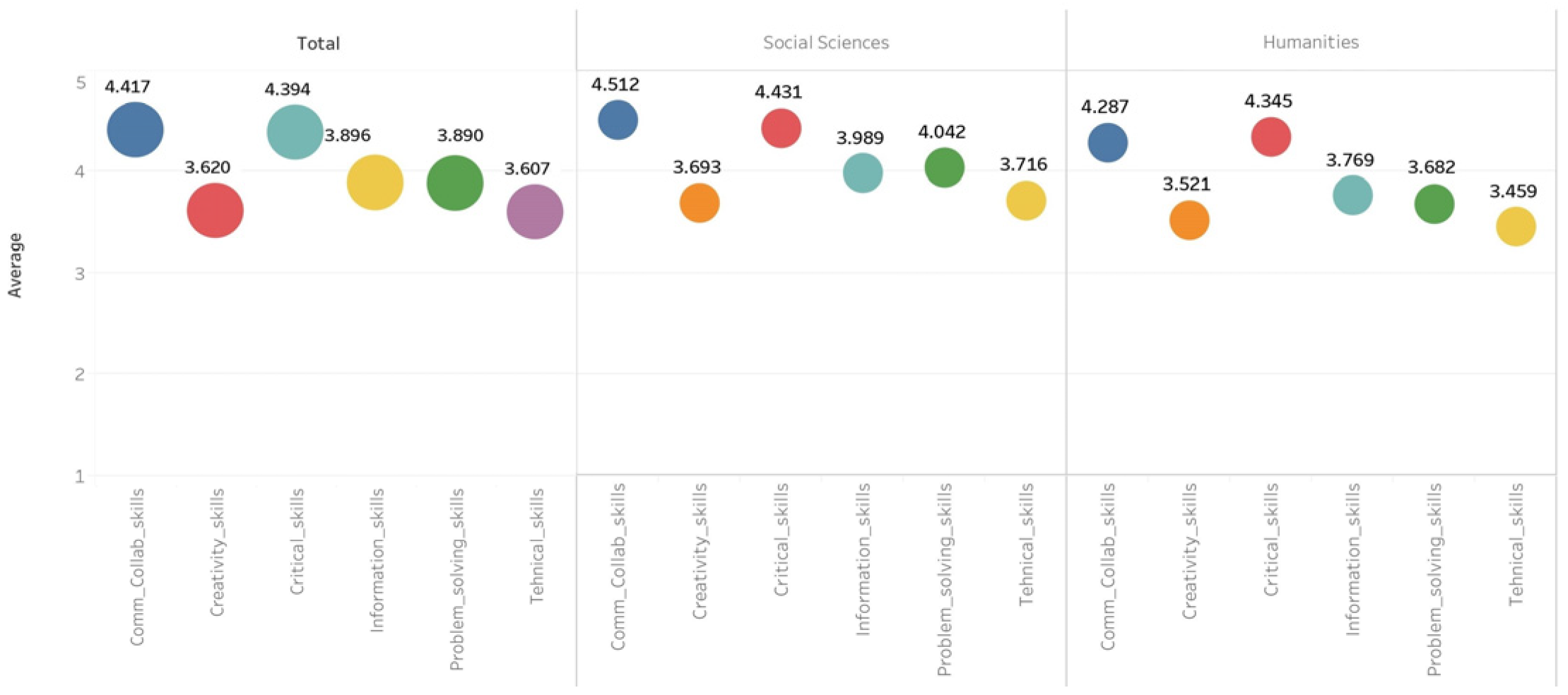
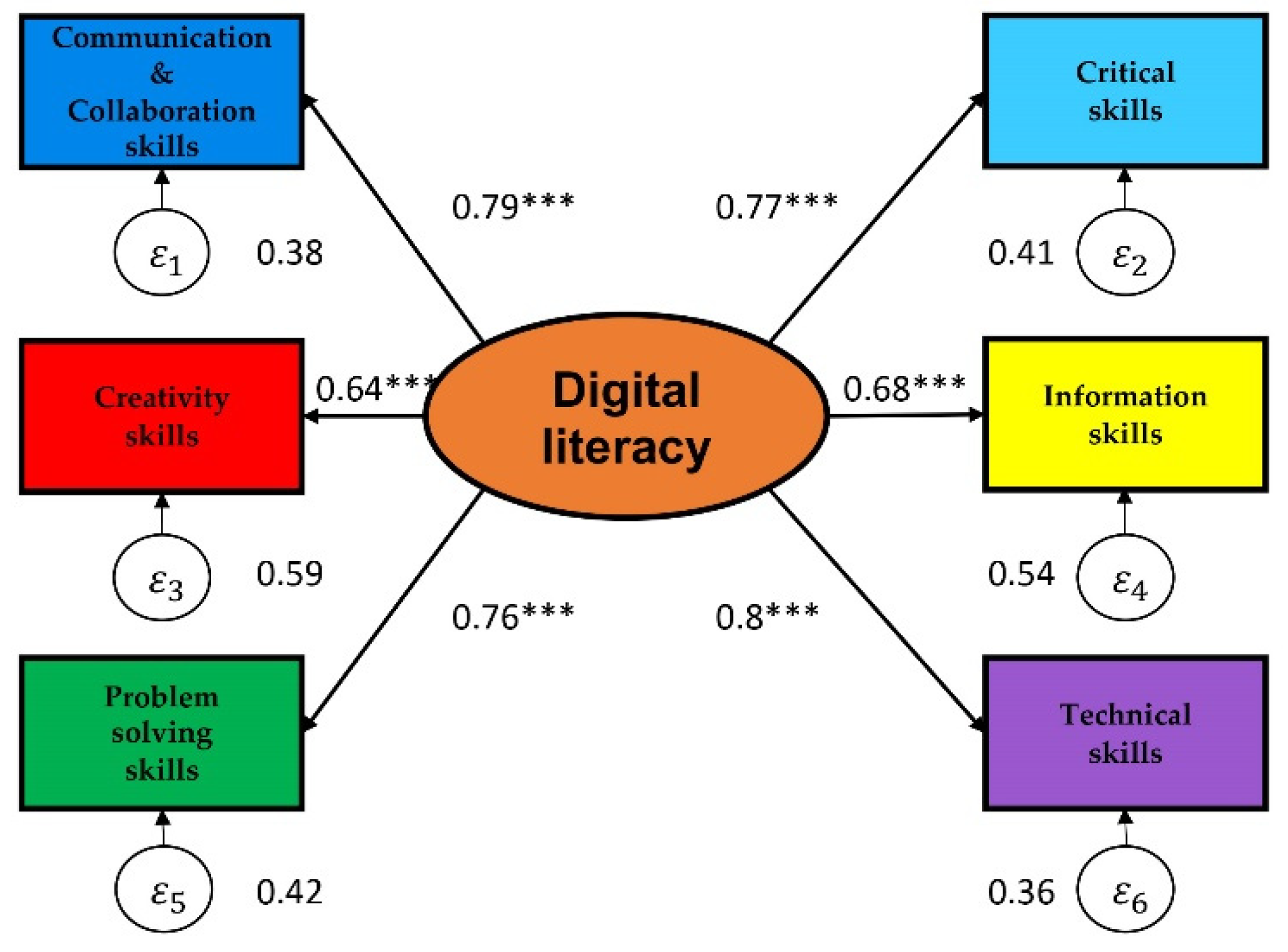
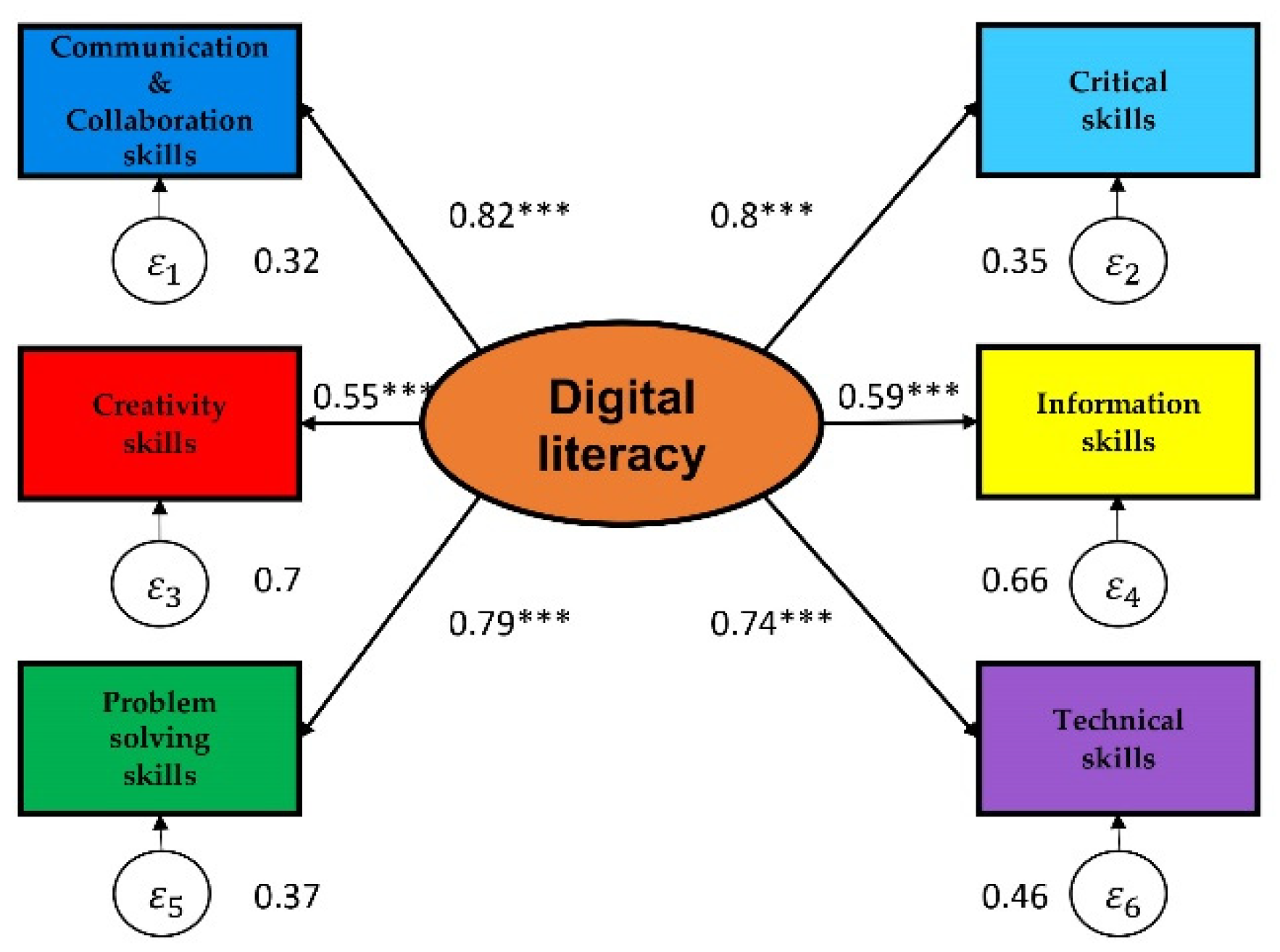
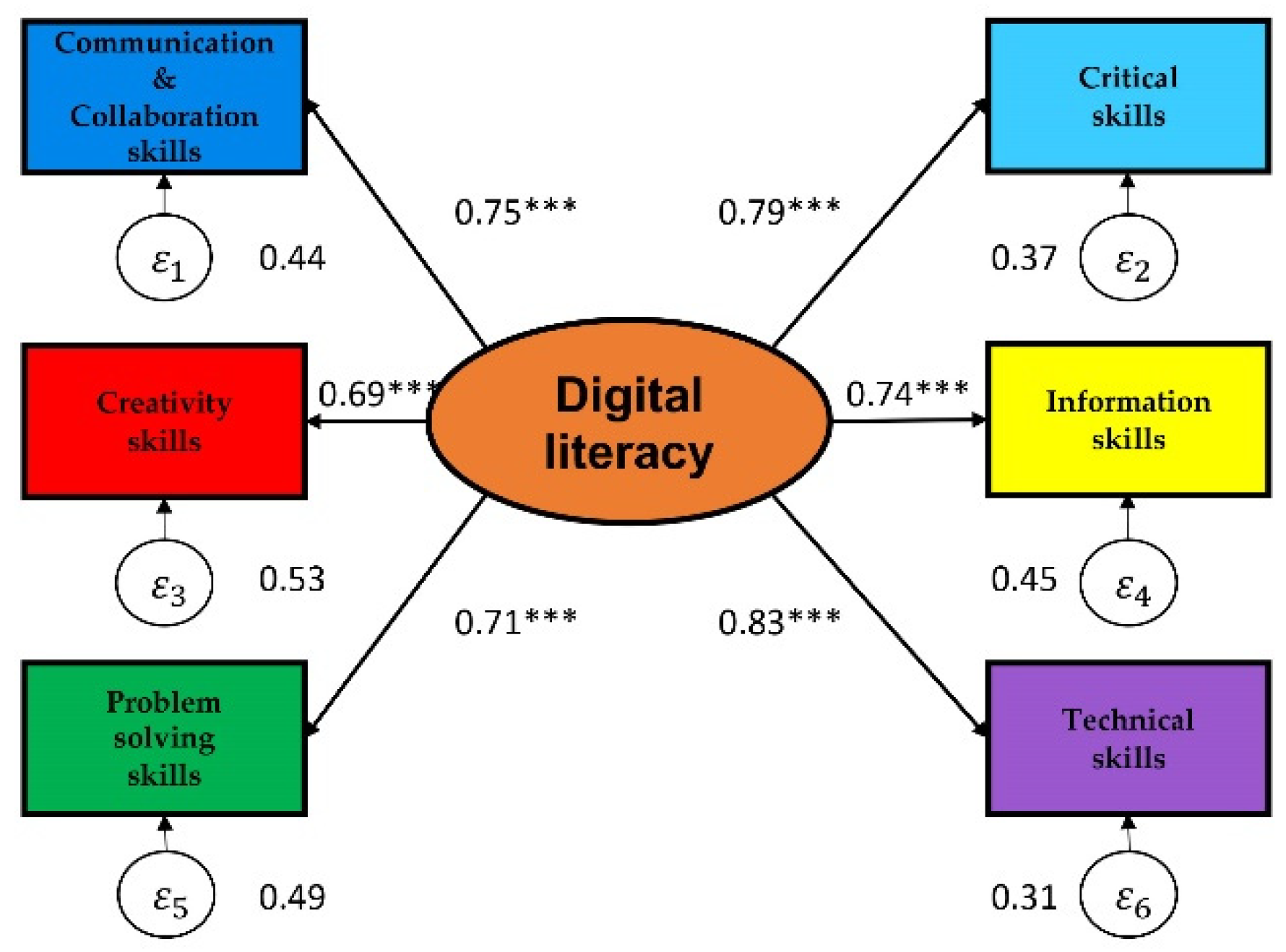
| Variable | Code | Description | No. of Items (Scale) |
|---|---|---|---|
| Digital skills | |||
| Communication and collaboration digital skills | Comm_ Collab_skills | The students’ ability to transmit information using digital environments and to share online content and media made by them or others and to collaborate with peers. Communication and Collaboration skills consists of six items, with answers evaluated on a five-point Likert scale (1 = strongly disagree; 5 = strongly agree). | 6 (1–5) |
| Creativity digital skills | Creativity_ skills | The students’ ability to create content by converting information into new knowledge. Creativity skills consists of six items, with answers evaluated on a five-point Likert scale (1 = strongly disagree; 5 = strongly agree). | 6 (1–5) |
| Critical thinking digital skills | Critical_skills | The students’ ability to think reflectively and judge skilfully the incoming online information and provide them with a safe, permanent and an easily accessible tool as well as a physical environment and, also, to formulate their own point of view. Critical_skills consist of five items, with answers evaluated on a five-point Likert scale (1 = strongly disagree; 5 = strongly agree). | 5 (1–5) |
| Information digital skills | Information_ skills | The students’ ability to search, evaluate and organize digital information. Information_skills was assessed using six questions from the questionnaire, where the respondents were evaluated on a five-point Likert scale (1 = strongly disagree; 5 = strongly agree). | 6 (1–5) |
| Problem-solving digital skills | Problem- solving _skills | The students’ ability to find solutions for the problems or to formulate strategies to determine the best solutions for them. Problem-solving skills consists of six items, with answers evaluated using a five-point Likert scale. | 6 (1–5) |
| Technical digital skills | Technical_ skills | The students’ ability to continuously adapt to new technologies. Technical_skills construct consists of nine items, with answers evaluated using a five-point Likert scale. | 9 (1–5) |
| Socio-demographic variables | |||
| Age | Age | A numerical variable where the respondent was asked to provide their age (in years). The variable was coded into three categories: 1 = 18–20 years old; 2 = 21–24 years old; 3 = 25 and over. | 1 (1–3) |
| Gender | Gender | Gender of the respondents. A variable which takes the value “0” when the respondent’s gender is male, and the value “1” when the respondent’s gender is female; | 1 (0–1) |
| Faculty field type | Faculty | A categorical variable representing the respondent’s fields of education: 1 = social sciences and 2 = humanities. | 1 (1–2) |
| Levels of education | Levels of education | A categorical variable representing the respondent’s education level in which the student accumulated digital skills. The question was defined as a multiple-answers one, having the following three categories: 1 = Primary, 2 = Secondary and 3 = Tertiary and all the possible combination in-between. | 1 (1–6) |
| Digital education courses | Digital education course enrolment | Enrolment at digital skills training courses. A dichotomous variable taking the value ”1” if the respondent answers affirmatively to the question and ”0” otherwise | 1 (0–1) |
| Variable | Cronbach’s Alpha | McDonald’s Omega | AVE | Correlation Coefficients | |||||
|---|---|---|---|---|---|---|---|---|---|
| 1. | 2. | 3. | 4. | 5. | 6. | ||||
| 1. Comm_Collab_skills | 0.829 | 0.825 | 0.661 | [0.813] a | |||||
| 2. Creativity_skills | 0.812 | 0.811 | 0.660 | 0.572 *** | [0.812] | ||||
| 3. Critical_skills | 0.780 | 0.780 | 0.592 | 0.639 *** | 0.412 *** | [0.769] | |||
| 4. Information_skills | 0.702 | 0.700 | 0.549 | 0.514 *** | 0.417 *** | 0.547 *** | [0.741] | ||
| 5. Problem-solving_skills | 0.821 | 0.827 | 0.543 | 0.568 *** | 0.465 *** | 0.605 *** | 0.511 *** | [0.737] | |
| 6. Technical_skills | 0.754 | 0.747 | 0.502 | 0.607 *** | 0.547 *** | 0.592 *** | 0.552 *** | 0.632 *** | [0.709] |
| Variable | Category | Frequency | Percentage (%) |
|---|---|---|---|
| Gender | Female | 179 | 69.1 |
| Male | 80 | 30.9 | |
| Age | 18–20 | 92 | 35.5 |
| 21–24 | 116 | 44.8 | |
| 25+ | 51 | 19.7 | |
| Faculty | Social sciences | 150 | 57.9 |
| Humanities | 109 | 42.1 |
| Variable | N | Min | Max | Mean | Std. dev. | Skewness | Kurtosis |
|---|---|---|---|---|---|---|---|
| Comm_Colab_skills | 259 | 1 | 5 | 4.438 | 0.620 | −1.993 | 6.814 |
| Creativity_skills | 259 | 1 | 5 | 3.637 | 0.811 | −0.305 | 0.004 |
| Critical_skills | 259 | 1 | 5 | 4.402 | 0.586 | −1.449 | 3.662 |
| Information_skills | 259 | 1 | 5 | 3.890 | 0.629 | −0.639 | 0.867 |
| Problem-solving_skills | 259 | 1 | 5 | 3.906 | 0.817 | −0.432 | −0.494 |
| Technical_skills | 259 | 1 | 5 | 3.627 | 0.598 | −0.027 | 0.117 |
| Variable | Levels of Education | Digital Education Course Enrolment | ||
|---|---|---|---|---|
| F Statistic | Sig | F Statistic | Sig | |
| Comm_Collab_skills | 2.565 | 0.028 | 5.371 | 0.021 |
| Creativity_skills | 0.936 | 0.458 | 7.682 | 0.006 |
| Critical_skills | 2.491 | 0.032 | 3.391 | 0.067 |
| Information_skills | 2.096 | 0.066 | 11.351 | 0.001 |
| Problem-solving_skills | 1.000 | 0.418 | 4.754 | 0.030 |
| Technical_skills | 1.700 | 0.135 | 7.093 | 0.008 |
| Latent Variable | Measurement Variables | Total | Social Sciences | Humanities | Hypothesis—Result | |||
|---|---|---|---|---|---|---|---|---|
| Std. Estimates | R2 | Std. Estimates | R2 | Std. Estimates | R2 | |||
| Digital literacy | Comm_Collab skills | 0.788 *** | 0.621 | 0.824 *** | 0.678 | 0.749 *** | 0.561 | H3a—Supported |
| Creativity skills | 0.640 *** | 0.410 | 0.550 *** | 0.303 | 0.687 *** | 0.473 | H3b —Supported | |
| Critical skills | 0.768 *** | 0.590 | 0.803 *** | 0.645 | 0.792 *** | 0.627 | H3c —Supported | |
| Information skills | 0.678 *** | 0.460 | 0.587 *** | 0.344 | 0.743 *** | 0.553 | H3d —Supported | |
| Problem-solving skills | 0.759 *** | 0.576 | 0.791 *** | 0.626 | 0.714 *** | 0.509 | H3e —Supported | |
| Technical skills | 0.799 *** | 0.639 | 0.735 *** | 0.680 | 0.828 *** | 0.675 | H3f —Supported | |
| Overall | 0.886 | 0.885 | 0.892 | |||||
| Fit Statistics | Total | Social Sciences | Humanities |
|---|---|---|---|
| RMSEA | 0.08 | 0.05 | 0.13 |
| CFI | 0.98 | 0.99 | 0.95 |
| TLI | 0.96 | 0.98 | 0.91 |
| SRMR | 0.03 | 0.03 | 0.04 |
Publisher’s Note: MDPI stays neutral with regard to jurisdictional claims in published maps and institutional affiliations. |
© 2022 by the authors. Licensee MDPI, Basel, Switzerland. This article is an open access article distributed under the terms and conditions of the Creative Commons Attribution (CC BY) license (https://creativecommons.org/licenses/by/4.0/).
Share and Cite
Vodă, A.I.; Cautisanu, C.; Grădinaru, C.; Tănăsescu, C.; de Moraes, G.H.S.M. Exploring Digital Literacy Skills in Social Sciences and Humanities Students. Sustainability 2022, 14, 2483. https://doi.org/10.3390/su14052483
Vodă AI, Cautisanu C, Grădinaru C, Tănăsescu C, de Moraes GHSM. Exploring Digital Literacy Skills in Social Sciences and Humanities Students. Sustainability. 2022; 14(5):2483. https://doi.org/10.3390/su14052483
Chicago/Turabian StyleVodă, Ana Iolanda, Cristina Cautisanu, Camelia Grădinaru, Chris Tănăsescu, and Gustavo Herminio Salati Marcondes de Moraes. 2022. "Exploring Digital Literacy Skills in Social Sciences and Humanities Students" Sustainability 14, no. 5: 2483. https://doi.org/10.3390/su14052483
APA StyleVodă, A. I., Cautisanu, C., Grădinaru, C., Tănăsescu, C., & de Moraes, G. H. S. M. (2022). Exploring Digital Literacy Skills in Social Sciences and Humanities Students. Sustainability, 14(5), 2483. https://doi.org/10.3390/su14052483










